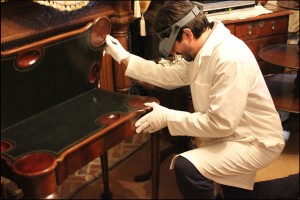Gregg Perry Conservation offers on-site care for objects that are too large or too unstable to move without complication or that only require minimal work. We can complete minor cosmetic treatments and preventative conservation in situ, including replacement of a minor veneer loss to polishing of an 18thcentury highboy. Our expert restorers can travel worldwide to execute minimal treatments in private homes as well as museums and historic houses.
The majority of furniture coming into our studio for treatment is often damaged due to long term exposure to conditions that affect its structure and surface. Excessive sunlight, moisture, temperature fluctuations, wood worm, surface dirt and contaminants in the air can cause permanent damage. Once conserved, the wooden object should be returned to a stable environment to minimize further deterioration.
When furniture is subjected to low levels of relative humidity, its timber gives up inter-cellular moisture in to the surrounding dry atmosphere. The wood and veneers start to crack and check along the grain primarily, and then with low ambient moisture adhesive failure results. This shrinkage is further aggravated when the underlying veneer substrate is perpendicular to the surface veneer. The carcass wood moves and the veneer consequently tears and lifts away. Once conserved, the ideal interior environment is 50-55% relative humidity, humidifying to this extent can be difficult in the heating season and conversely difficult to dehumidify in the summer in some United States locations. A hygrometer in each room can be used to monitor humidity levels in each room. Also, rapid temperature fluctuations in a short duration of time can cause a great deal of damage even though the piece may have survived centuries with slow temperature transitions.
To some degree a limited amount of sunlight over a long period of time can create a mellow color in an antique piece of furniture, combined with surface dirt and waxes can produce a desirable patina for collectors. However, excessive sunlight can damage a piece significantly by drying out the molecular bonds in the polished surface and also the underlying timber and veneer. Guardians of furniture have a few options; having ultraviolet film professionally installed on their windows, draw window shades when rooms are not in use and when possible, rotate the pieces occasionally to even out the fading process.
Once or twice a year furniture should have a good quality paste wax applied to its surface. The wax should be buffed with a soft cotton cloth. This wax-laden cloth can be used as a duster. Over time, with repetitive waxings a hard skin will build up creating a good surface color known as patina. Do not use spray polishes as they contain silicone which builds up a sticky surface. Silicone molecules are very small and difficult to remove from the finished surface.
Periodically inspect your furniture for lifting veneers (hollow sound when tapped), water damage and loose joints. During the months and hours of May-June look for the fresh dust from the furniture beetle (wood worm). Carefully store with the piece of furniture any pieces of molding or veneer that may fall off. This will help keep the piece of furniture original at the time of restoration.

